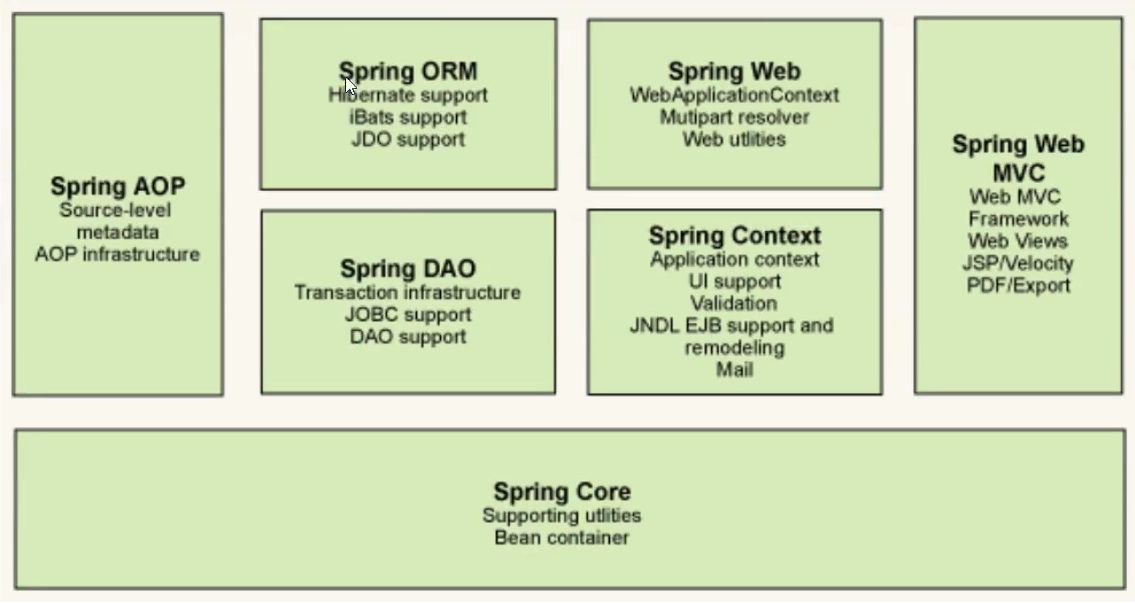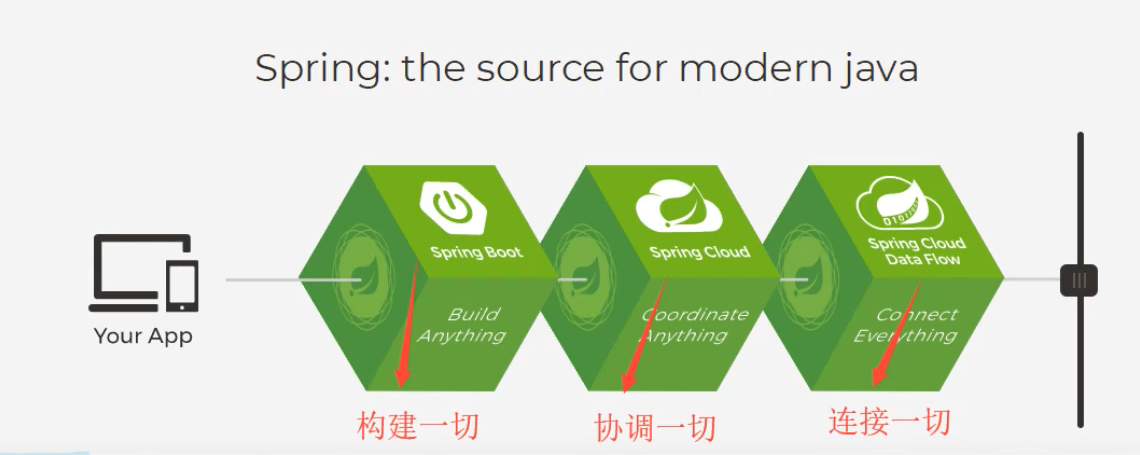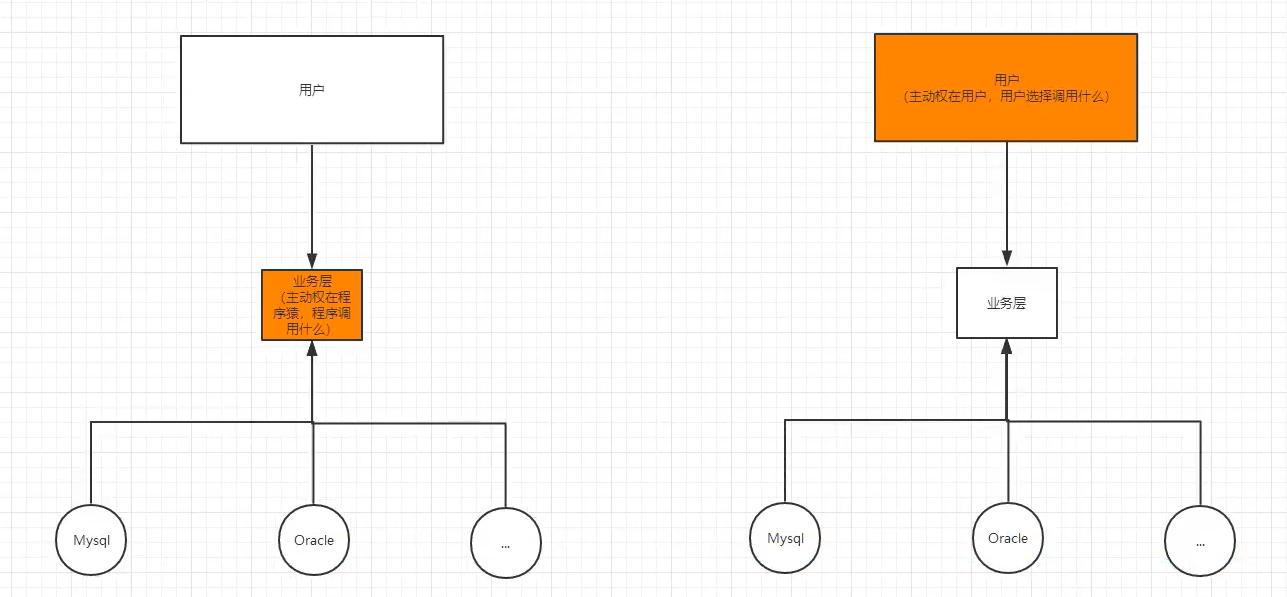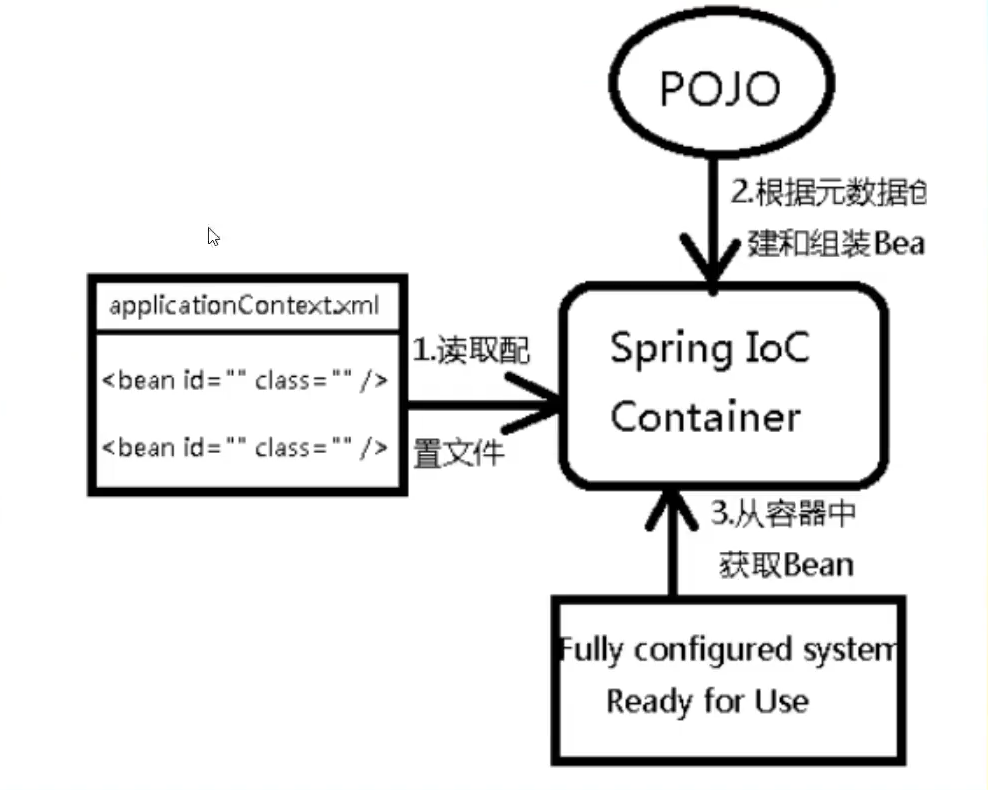Spring基础
1 Spring
1.1 spring优点
- spring是一个开源的免费框架
- spring是一个轻量级、非入侵式的框架
- 控制反转(IOC),面向切面
- 支持事务的处理,对框架整合的支持!
总结一句话:Spring是一个轻量级的控制反转(IOC)和面向切面变成(AOP)的框架!!
1.2 spring组成

1.3 拓展
在spring的官网有这个介绍,现代化java开发,说白了就是基于spring开发

springboot
- 是一个快速开发的脚手架,
- 基于springboot可以快速开发单个微服务
- 约定大于配置
springcloud
- 基于springboot实现
现在大多数公司都在使用springboot进行快速开发使用,学习springboot的前提是完全掌握spring和springmvc!
spring起到承上启下的作用!!
弊端:spring发展太久之后违背了原来的理念,配置十分繁琐,人称"配置地狱"!!!!
2 IOC理论推导
使用spring之前
-
userDao接口
package com.wshy.Dao; /** * @author wshy * @data 2021/7/31 **/ public interface UserDao { void getUser(); } -
userDaoImpl实现类
package com.wshy.Dao; /** * * @title: UserDaoImpl * @Author: wshy */ public class UserDaoImpl implements UserDao { @Override public void getUser () { System.out.println ("默认获取用户的数据"); } } -
userService业务接口
package com.wshy.Service; /** * @author wshy * @data 2021/7/31 **/ public interface UserService { void getUser(); } -
userServiceImpl业务实现类
package com.wshy.Service; import com.wshy.Dao.UserDao; import com.wshy.Dao.UserDaoImpl; /** * * @title: UserServiceImpl * @Author: wshy */ public class UserServiceImpl implements UserService{ private UserDao userDao = new UserDaoImpl (); @Override public void getUser () { userDao.getUser (); } }5.测试类
import com.wshy.Service.UserService; import com.wshy.Service.UserServiceImpl; /** * * @title: MyTest * @Author: wshy */ public class MyTest { public static void main (String[] args) { // 用户实际调用的是业务层,Dao层并不接触 UserService userService = new UserServiceImpl (); userService.getUser (); } }6.结果打印

此时,如果业务需求增加,需要增加一个mysql实现类,需要增加UserDaoMySqlImpl、UserServiceImpl
着重看UserServiceImpl业务层实现类的new对象的操作,修改为private UserServiceMySqlImpl userDao = new UserServiceMySqlImpl ();package com.wshy.Dao; import com.wshy.Service.UserService; /** * @title: UserServiceMySqlImpl * @Author: wshy */ public class UserServiceMySqlImpl implements UserService { @Override public void getUser () { System.out.println ("Mysql实现类"); } }package com.wshy.Service; import com.wshy.Dao.UserDao; import com.wshy.Dao.UserDaoImpl; import com.wshy.Dao.UserServiceMySqlImpl; /** * * @title: UserServiceImpl * @Author: wshy */ public class UserServiceImpl implements UserService{ //private UserDao userDao = new UserDaoImpl (); private UserServiceMySqlImpl userDao = new UserServiceMySqlImpl (); @Override public void getUser () { userDao.getUser (); } }返回结果:

接着如果再增加一个Oracle实现类,需要重复以上操作,需要增加UserDaoOracleImpl实现类、并修改UserServiceImpl对Dao层实现类对象创建
将UserServiceImpl业务层实现类的new对象的操作,修改为private UserServiceOracleImpl userDao = new UserServiceOracleImpl ();
package com.wshy.Service;
import com.wshy.Dao.UserDao;
import com.wshy.Dao.UserDaoImpl;
import com.wshy.Dao.UserServiceMySqlImpl;
import com.wshy.Dao.UserServiceOracleImpl;
/**
*
* @title: UserServiceImpl
* @Author: wshy
*/
public class UserServiceImpl implements UserService{
//private UserDao userDao = new UserDaoImpl ();
//private UserServiceMySqlImpl userDao = new UserServiceMySqlImpl ();
private UserServiceOracleImpl userDao = new UserServiceOracleImpl ();
@Override
public void getUser () {
userDao.getUser ();
}
}
返回结果:

那么问题来了,如果业务需要实现的类越来越多,那么每次都要手工去修改业务层UserService中对Dao层UserDaoXXXService实现类对象的创建
这样的操作,每当有请求修改,都要去修改代码,这种设计是不合理的!!!!
可以在业务层UserServiceImpl中对象的创建使用set注入,然后在测试类中,传入需要注入的对象即可,这样就不需要每次都去修改业务层的代码,不用在业务层每次都去new一个Dao层对象。
如下是对UserServiceImpl、MyTest中的修改及结果
package com.wshy.Service;
import com.wshy.Dao.UserDao;
import com.wshy.Dao.UserDaoImpl;
import com.wshy.Dao.UserServiceMySqlImpl;
import com.wshy.Dao.UserServiceOracleImpl;
import java.util.Set;
/**
*
* @title: UserServiceImpl
* @Author: wshy
*/
public class UserServiceImpl implements UserService{
//private UserDao userDao = new UserDaoImpl ();
//private UserServiceMySqlImpl userDao = new UserServiceMySqlImpl ();
//private UserServiceOracleImpl userDao = new UserServiceOracleImpl ();
private UserDao userDao;
// 利用set进行动态实现值得注入
public void setUserDao (UserDao userDao) {
this.userDao = userDao;
}
@Override
public void getUser () {
userDao.getUser ();
}
}
import com.wshy.Dao.UserDaoImpl;
import com.wshy.Dao.UserServiceMySqlImpl;
import com.wshy.Service.UserService;
import com.wshy.Service.UserServiceImpl;
/**
*
* @title: MyTest
* @Author: wshy
*/
public class MyTest {
public static void main (String[] args) {
// 用户实际调用的是业务层,Dao层并不接触
UserServiceImpl userService = new UserServiceImpl ();
userService.setUserDao(new UserServiceMySqlImpl ());
userService.getUser ();
}
}

以上程序发生了本质的变化
- 之前,程序是主动创建对象,控制权在程序员手中
- 现在,使用set注入后,程序不再具有主动性,而是变成了被动的接收对象
这种思想,本质上解决了问题,我们程序员不用再去管理对象的创建了,系统耦合性大大降低!!!可以更加专注的在业务实现上,这是IOC的原型!

3.IOC本质
控制反转(IOC),是一种设计思想,DI(依赖注入)是实现IOC的一种方法
在没有IOC的程序中,我们使用面向对象编程,对象的创建于对象之间的依赖关系完成硬编码的方式在程序中体现,对象的创建有程序自己控制,控制反转后将对象的创建转移到第三方,其本质就是**获得依赖对象的方式反转了**
从下面的图可以帮助理解
- 图一,各个对象之间是强耦合的,程序决定依赖关系
- 图二,各个对象中间加了一个中间容器,IOC容器,负责将各个对象之间关系进行解耦
- 图三,各个对象之间的调用,没有任何耦合性

IOC是Spring框架的核心内容,使用多种方式完美的实现了IOC,可以使用IOC的方式,可以使用注解的方式,也可以使用Spring新特性中的零配置(自动注入)实现IOC
spring在初始化时,先读取配置文件,根据配置文件信息或元数据创建组织对象存入容器中,程序使用时,再从IOC容器中获取所需对象。

4.HelloSpring
4.1 hello.java
package com.wshy.pojo;
/**
* @title: Hello
* @Author: wshy
*/
public class Hello {
private String str;
public String getStr () {
return str;
}
public void setStr (String str) {
this.str = str;
}
@Override
public String toString () {
return "Hello{" +
"str='" + str + '\'' +
'}';
}
}
4.2 beans.xml
<?xml version="1.0" encoding="UTF-8"?>
<beans xmlns="http://www.springframework.org/schema/beans"
xmlns:xsi="http://www.w3.org/2001/XMLSchema-instance"
xsi:schemaLocation="http://www.springframework.org/schema/beans http://www.springframework.org/schema/beans/spring-beans.xsd">
<!--使用spring创建对象,在spring中这些都被成为Bean-->
<bean id="hello" class="com.wshy.pojo.Hello">
<property name="str" value="Spring"/>
</bean>
</beans>
4.3 MyTest
import com.wshy.pojo.Hello;
import javafx.application.Application;
import org.springframework.context.ApplicationContext;
import org.springframework.context.support.ClassPathXmlApplicationContext;
/**
* @title: MyTest
* @Author: wshy
*/
public class MyTest {
public static void main (String[] args) {
// 获取spring的上下文对象
ApplicationContext context = new ClassPathXmlApplicationContext ("beans.xml");
//我们的对象都在spring中管理了,我们要使用,直接去里面取就好了,取id为hello的Bean
Hello hello = (Hello) context.getBean ("hello");
System.out.println (hello.toString ());
}
}
4.4 结果

4.5 解析说明
beans.xml解析
<?xml version="1.0" encoding="UTF-8"?>
<beans xmlns="http://www.springframework.org/schema/beans"
xmlns:xsi="http://www.w3.org/2001/XMLSchema-instance"
xsi:schemaLocation="http://www.springframework.org/schema/beans http://www.springframework.org/schema/beans/spring-beans.xsd">
<!--使用spring创建对象,在spring中这些都被成为Bean-->
<!--
以前创建对象
类型 变量名 = new 类型();
Hello hello = new Hello();
使用Beans.xml配置文件后
id = 变量名
class = new 对象
property 相当于给对象中的属性设置一个值
-->
<bean id="hello" class="com.wshy.pojo.Hello">
<property name="str" value="Spring"/>
</bean>
</beans>
4.6 以spring的方式修改以前创建对象的方式
添加beans.xml
<?xml version="1.0" encoding="UTF-8"?>
<beans xmlns="http://www.springframework.org/schema/beans"
xmlns:xsi="http://www.w3.org/2001/XMLSchema-instance"
xsi:schemaLocation="http://www.springframework.org/schema/beans http://www.springframework.org/schema/beans/spring-beans.xsd">
<bean id="mysqlImpl" class="com.wshy.Dao.UserServiceMySqlImpl" />
<bean id="oracleImpl" class="com.wshy.Dao.UserServiceOracleImpl" />
<!--
ref:引用spring容器中创建好的对象
value:具体的值,基本数据类型
-->
<bean id="userServiceImpl" class="com.wshy.Service.UserServiceImpl">
<property name="userDao" ref="mysqlImpl"/>
</bean>
</beans>
修改MyTest.java
/**
* @author wshy
* @data 2021/7/31
**/
import com.wshy.Dao.UserDaoImpl;
import com.wshy.Dao.UserServiceMySqlImpl;
import com.wshy.Service.UserService;
import com.wshy.Service.UserServiceImpl;
import org.springframework.context.ApplicationContext;
import org.springframework.context.support.ClassPathXmlApplicationContext;
/**
*
* @title: MyTest
* @Author: wshy
*/
public class MyTest {
public static void main (String[] args) {
// 用户实际调用的是业务层,Dao层并不接触
//UserServiceImpl userService = new UserServiceImpl ();
//userService.setUserDao(new UserServiceMySqlImpl ());
//
//userService.getUser ();
ApplicationContext context = new ClassPathXmlApplicationContext ("beans.xml");
UserServiceImpl userServiceImpl = (UserServiceImpl) context.getBean ("userServiceImpl");
userServiceImpl.getUser ();
}
}
运行结果

此时,如果想要修改业务,只需要修改配置文件中的ref引用为oracleImpl,接口打印出**Oracle实现类
总结
- hello对象是由spring创建的
- hello对象的属性是在spring配置文件中设置的
这个过程就是控制反转:
- 控制:谁来控制对象的创建,传统应用程序的对象是由程序本身创建的,使用spring后,对象由spring来创建
- 反转:程序本身不创建对象,而变成被动的接收对象
- 依赖注入:就是利用set方法来实现注入的
IOC是一种编程思想,由主动创建对象 ,变为被动接收
我们可以彻底不用修改代码,而去实现不同的操作,只需要在xml配置文件中红进行修改,所谓的IOC,就是由spring来创建、管理、装配对象!
